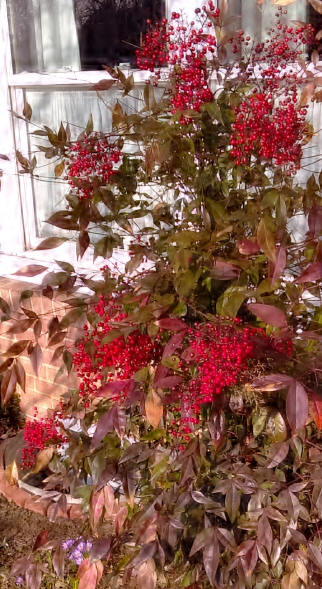Planning ahead to the next season is always a good thing to do. I'm trying to set a good example! It's always nice at Christmastime to decorate with fresh flowers and berries. But you have to plant the shrubs or plants in the spring in order to use them in December.
Here are some good choices for brightly colored branches or berries. These are all plants that grow in our area and they are common enough that you will be able to find them in the nurseries in spring or even in the fall and then you will always have them available for arranging or bringing into your house in fall and winter. Most will last for a couple weeks in water indoors or you can make a temporary arrangement by filling a metal pail with sand and arranging your brightly colored leaves or branches or berries so that you might have an arrangement that will last from October to early spring. It's always nice to include evergreen branches such as spruce, hemlock, or pine branches. You can include some pinecones or interesting gnarled wood to your arrangement. I mention red twig dogwood, but there is also yellow twig dogwood and a coral-colored willow shrub which is similar in shape to the red twig dogwood. Both plants also have very
interesting stem color.
 The nandina (Nandina domestica) is a terrific shrub. My first nandina was bought about 20 years ago and now has turned into a grouping of these shrubs. When the berries fall off, some of them may germinate or they also grow by runners. The hardiness zone for nandina 20 years ago was really recommended for zone 7 and it was recommended to put it in a protected spot. We have warmed up and are in zone 6B so now you see nandina everywhere and all very healthy. They can be particularly nice planted against a brick wall or a fence. The berries are very bright red and last on the shrubs for most of the winter. It is not a native shrub so birds are not especially interested in it but by spring if there are withered berries still on the branches, robins may eat them. The leaves are
also very attractive — a very dark green in summer, but they change in fall to dark burgundy, purple, red, and green mixed. They last till early spring and eventually all fall off, but slowly so you never see a naked shrub.
The nandina (Nandina domestica) is a terrific shrub. My first nandina was bought about 20 years ago and now has turned into a grouping of these shrubs. When the berries fall off, some of them may germinate or they also grow by runners. The hardiness zone for nandina 20 years ago was really recommended for zone 7 and it was recommended to put it in a protected spot. We have warmed up and are in zone 6B so now you see nandina everywhere and all very healthy. They can be particularly nice planted against a brick wall or a fence. The berries are very bright red and last on the shrubs for most of the winter. It is not a native shrub so birds are not especially interested in it but by spring if there are withered berries still on the branches, robins may eat them. The leaves are
also very attractive — a very dark green in summer, but they change in fall to dark burgundy, purple, red, and green mixed. They last till early spring and eventually all fall off, but slowly so you never see a naked shrub.
Winterberry holly or Ilex verticillata is a deciduous holly — it loses its leaves in the winter. But the advantage to this is that you can easily see the many berries that are produced and become a vivid red in the winter. These shrubs pictured are approximately 10 years old and obviously love the space they are in — part sun. The berries begin to turn red in late fall and will last through the winter. There are plenty to use to decorate for Christmas. Birds begin to eat them in January-February and by spring they are gone. Robins especially like them as winter goes on. This shrub needs a male to pollinate the female flowers that appear in spring. The two types of holly do not need to be next to each other. The male does not get berries so it can be put in the back of a border or another unobtrusive area of your yard. There are many plants that need to have a male and a female to produce good fruit. Be sure to ask at a plant nursery
which plants make good mates. You will only need one male to supply pollen to several female shrubs.
The extra benefit of choosing some of these plants with brightly colored berries, stems or even bark will mean that you may add to the winter interest of your outdoor garden in what can be a drab season of bare trees or shrubs. Keep in mind the picture you want to see when you look out your windows in winter — with careful planning it can be extremely beautiful!
Read other articles on garden and landscape design
Read other winter related gardening articles
Read other articles by Martie Young